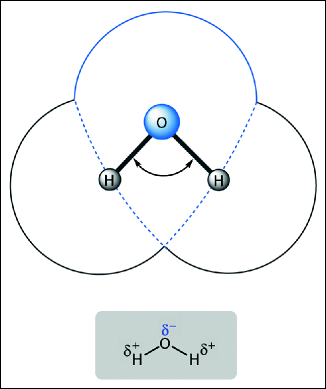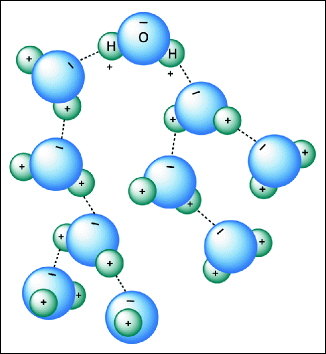, Maneli Mozaffarieh1 and Hans Bebie2
(1)
Department of Ophthalmology, University of Basel, Basel, Switzerland
(2)
Institute for Theoretical Physics, University of Bern, Bern, Switzerland
Abstract
Besides oxygen, water is essential to sustain life on earth. This molecule, which we often take for granted, is quite phenomenal (see Chapter 18). H2O can change its physical state from ice to liquid (water) to steam within a temperature range of 100 °C. The important feature of water is its polar nature. Since the oxygen atom in the water molecule has a higher electronegativity than hydrogen, the electrons are not homogeneously distributed but are, rather, closer to the oxygen than the hydrogen atom. This creates a weak electrical field, with a negative pole at the oxygen and a positive pole at the hydrogen (Fig. 10.1).
10.1 What Is Water?
Besides oxygen, water is essential to sustain life on earth. This molecule, which we often take for granted, is quite phenomenal (see Chapter 18). H2O can change its physical state from ice to liquid (water) to steam within a temperature range of 100 °C. The important feature of water is its polar nature. Since the oxygen atom in the water molecule has a higher electronegativity than hydrogen, the electrons are not homogeneously distributed but are, rather, closer to the oxygen than the hydrogen atom. This creates a weak electrical field, with a negative pole at the oxygen and a positive pole at the hydrogen (Fig. 10.1).


Fig. 10.1
Dipole nature of water. An important feature of water is its polar nature. The water molecule forms an angle, with hydrogen atoms at the tips and oxygen at the vertex. The side of the molecule with the oxygen atom has a partial negative charge, whereas the side with the hydrogen atom is partially positive. This charge difference (or dipole) causes water molecules to be attracted to each other and to other polar molecules
If the kinetic energy of the molecules falls below a certain limit (at 0 °C), the forces resulting from the kinetic energy are lower than the mutual attractions; therefore, the liquidity disappears (ice formation). More detailed information can be found in Chapter 18. On the other hand, if the kinetic energy exceeds a certain limit (at 100 °C), the resulting forces are large enough to disrupt the hydrogen bonds (Fig. 10.2), allowing the individual molecules to escape (steam formation). Water not only has a high fluidity but is also transparent and colorless because the molecules are small and have no double bonds, so they allow light

to travel through without scattering or absorption. The high solubility and weak polarity make water an ideal solvent for ions (e.g., Na+, Cl−) or any molecules with a certain polarity (e.g., glucose). In crystal form (ice), the water molecules are less densely packed due to the formation of hexagonal crystals and the increase in hydrogen bonding. Therefore, the specific weight of ice is lower than that of water. This is the reason that ice floats on water. This may seem trivial, but it is actually quite important as the ice would otherwise fall into deep seas and would not melt by the following summer. This would be disastrous in the long run, as most of the sea would consist of ice. The fact that ice requires greater volume than water also explains why a water pipe can break open in freezing temperatures.
< div class='tao-gold-member'>

Fig. 10.2
Hydrogen bonding, a relatively weak attraction between the water molecules, responsible for a number of water’s physical properties
Only gold members can continue reading. Log In or Register to continue
Stay updated, free articles. Join our Telegram channel

Full access? Get Clinical Tree


